Pearl Academy M. Des 2026
No. 1 Design & Fashion Institute by ASSOCHAM, India Today, Outlook and The Week rankings
CEED Admit Card Date:08 Jan' 26 - 08 Jan' 26
The Common Entrance Examination for Design (CEED) is an entrance exam for postgraduate design programs. This test is offered annually by all Indian Institutes of Technology. The Scorecard has been proven to be legitimate for admission to a number of prestigious Indian universities, including World Design University (Sonipat), Shiv Nadar University (SNU, Greater Noida), and Avantika University (Ujjain), in addition to IITs that offer design courses. As a result, students must study diligently in order to pass the CEED 2026 exam. The CEED 2026 exam is scheduled for January 18, 2026, according to the Indian Institutes of Technology.
This Story also Contains

One well-known entrance exam that students interested in continuing a postgraduate career in design might take to get started is the CEED entrance exam. The reputation is well-received both in India and beyond. For this reason, each design candidate must prepare for the CEED 2026.
Stage: 01 - (Computer Based Test- CBT)
Total Duration: 03 hours
Marks: 200
Duration: 1 hours
Marks: 150 (evaluated online)
Question Type: NAT+ MCQ’s+ MSQ’s
Format
The answer must be marked by filling in the information (NAT) or selecting the correct options (MCQ & MSQ).
Numerical Answer Type (NAT): Questions requiring numerical answers (4 marks each, no negative marking).
Multiple Choice Questions (MCQs): Questions with more than one correct answer choice (3 marks each for correct answer, 0.5 negative marking for incorrect answers).
Multiple Select Questions (MSQs): Questions with multiple answer choices, but you can choose more than one answer (4 marks with partial marking based on correct selections, -1 mark for incorrect selections).
Provided below is the Question pattern for 2024 CEED Examination
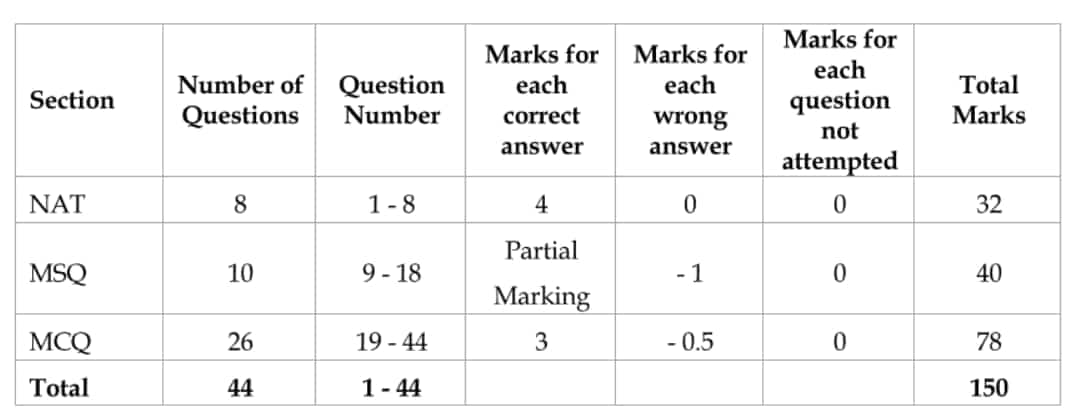
Also check: Check Subject-wise study material for CEED
This section assesses your ability to interpret design problems, analyze information, develop creative solutions, and communicate your ideas visually through drawing and writing.
Duration: 2 hours
Marks: 100 (evaluated offline)
Question Type: Drawing-based questions testing design, Sketching, and Communication Skills, Form Sensitivity, Visual Sensitivity
Format: Printed Answer Booklets are provided for sketching and writing the responses.
(Bifurcation of Section-B as per 2024 CEED Examination)
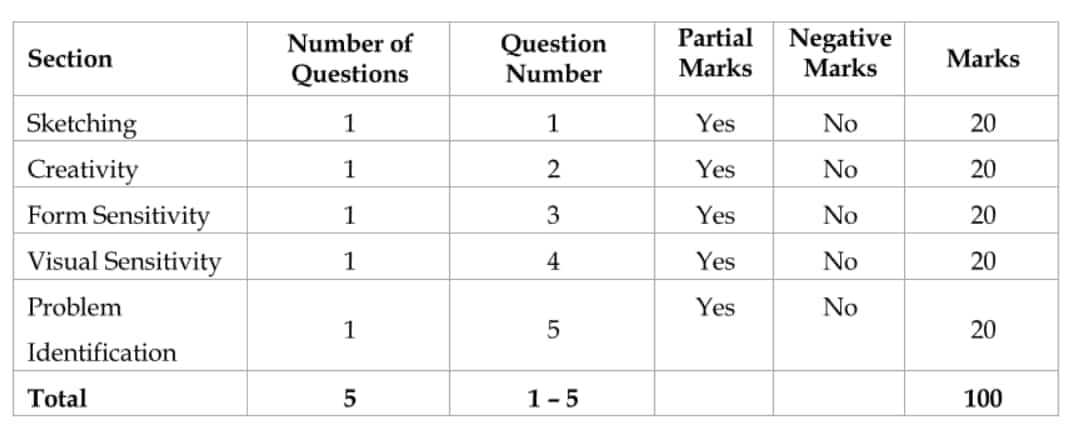
The final CEED score is calculated by giving weightage to both parts:
25% weightage to Part A score.
75% weightage to Part B score.
Note: Section B is only evaluated if the aspirant qualifies for the Section-A cutoff.
Section B (Drawing Test) is the most crucial part to be focused.
To crack CEED 2026, a strong grasp of the Syllabus for CEED 2026 is crucial. While some topics overlap with UCEED, CEED exams are more challenging and focus on testing versatile skills.
Visualization and Spatial Reasoning: Ability to transform 2D shapes to 3D objects and understand spatial relationships.
Practical and Scientific Knowledge: Knowledge of everyday objects and scientific principles.
Observation and Design Sensitivity: Developing attention to detail, classification, analysis, and prediction.
Analytical and Logical Reasoning: Ability to interpret qualitative and quantitative information.
Language Proficiency: Comprehension of standard English.
Art and Design Knowledge: Awareness of design history, trends, and artists.
Drawing: Ability to sketch with good composition, proportion, and shading.
Creativity: Developing innovative solutions to design problems.
Communication Skills: Clear and effective expression of concepts through visual communication.
Problem Identification: Understanding the user and context in design scenarios.
Start with Previous Year Questions Paper: While doing CEED preparation online, refer to the previous year's question papers or CEED sample papers. Practicing more questions will always provide candidates with better conceptual clarity and understanding. The previous year's CEED question papers are available on the official website. Solving the sample papers or previous years is the best way to get familiar with the examination's topics and structure.
Practice Non-Verbal Reasoning from Diverse Examinations: The idea is to train the mind for time-based interpretation of as many possible and diverse questions like Pictorial problems, Analogy, Paper Cutting and Folding, Mirror Image, & Reflection, etc.
Brush up Elementary Math & Science Fundamentals: General Awareness of fundamentals of Math and Science up to class 10th are leverage points for anyone appearing for the CEED Examination to solve most questions fast through concepts and logic mixed.
Attempt The Mock Tests: While doing CEED exam preparation, attempt the regular Mock Tests. The CEED Mock Test can help students practice more questions focusing on Part-A which can help to increase their speed and accuracy. Scoring well in Part-A plays a very crucial role in getting Part-B checked. So it is advisable to work on sections that you feel are your strengths at the core.
Five questions comprise Part B of the CEED 2026, which tests students' creative and artistic drawing skills. These five inquiries will come from themes like problem identification, sketching, inventiveness, form sensitivity, and visual sensitivity. Thus, to qualify CEED exam, candidates must possess a firm grasp of their drawing portion. Let's examine how you might improve your drawing abilities in more detail.
Developing the Drawing: Ability: Develop the skill to draw products, people, or scenes in proportion with good line quality, composition, proportion, perspective, and shading.
Activity for Drawing Ability: Expose yourself to markets, cityscapes, etc., with A4/A3 Sheets and try to sketch the scenarios with a pencil, keeping only the understanding of Scale & Proportions at focus.
Visual Communication: This is a critical skill for communicating concepts and ideas clearly with the help of text and visuals. Developing a style in person helps keep uniformity and speed while attempting the questions.
Activity for Communication Skills: Take a Brand like TATA and gather 05 different products from the same category, like FMCG products, and bring out the Logos for all the products, taking inspiration from existing ones using uniform color language with no more than 03 colors complimenting the product.
Growing Problem Mapping Skills in Daily Life Scenarios: Skills to understand the user and the context, knowledge of properties of materials and their appropriate use in design
Also Read:
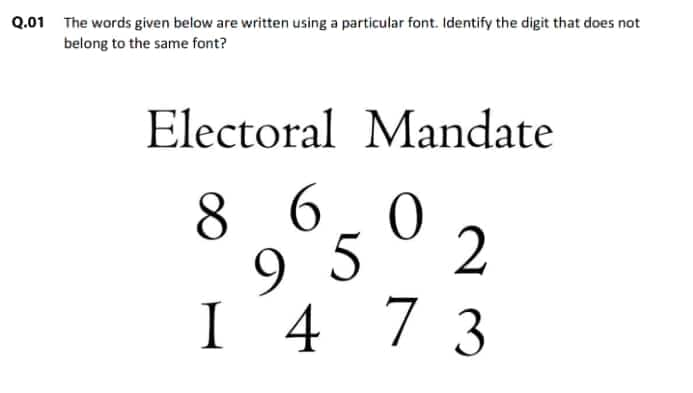
Solution: As Marked
Here, digit 2 has a thick font and different serif. It does not belong to the same font.

Q.09 Shown below are perspective views of a hexagonal prism,a cube and cylinder, all having height 10 cm.If the objects are cut by straight planes generate various cross sections, which of the statements is/areTRUE?
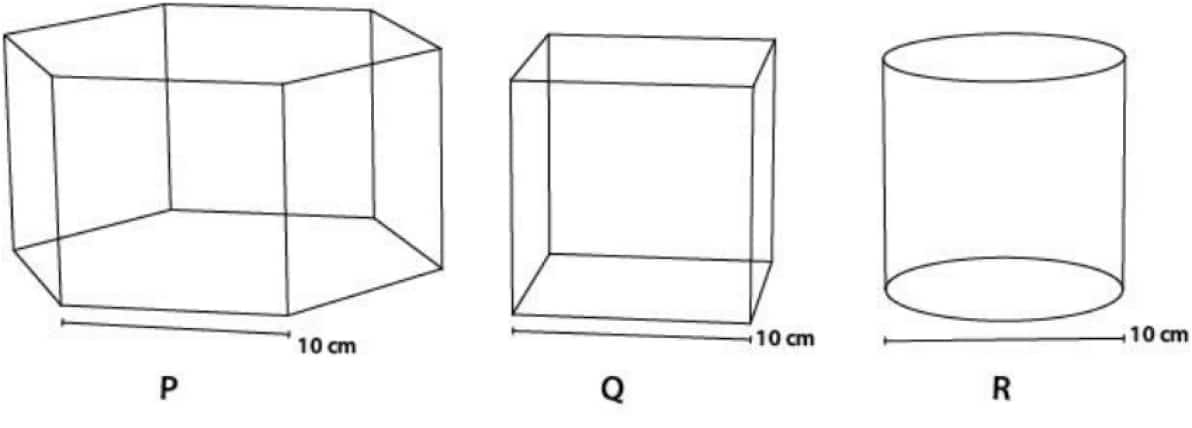
A.R can reveal curvilinear cross section; P and R can reveal a square cross section
B.P, Q and R can reveal rectangular cross sections; P and Q canreveal isosceles triangle
C.P and Q can reveal regular hexagonal cross sections; R can reveal a square
D.P and Q can reveal triangular cross sections; R can reveal atriangularcross section
Solution : A,B and C are correct because,
P (Hexagonal Prism): A straight cut can create rectangles (side view), hexagons (top view), or triangles (diagonal cut).
Q (Cube) : A straight cut can give rectangles or squares, and a diagonal cut can make triangles.
R (Cylinder) : A vertical cut gives a rectangle, a horizontal cut gives a circle, and a slanted cut gives a curved section.
Q. 19 Shown below are words in a particular font.Which option belongs to the same font?
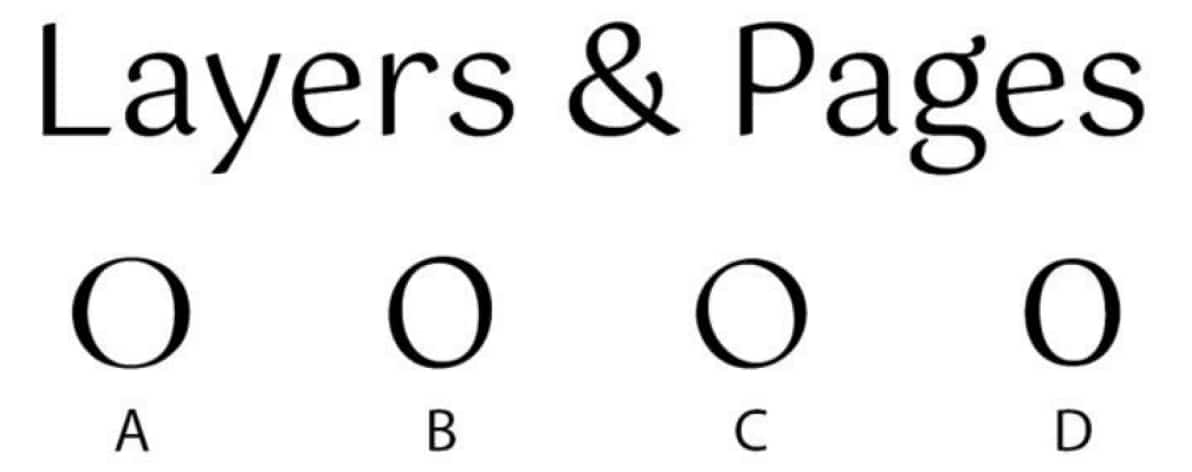
Solution : B is correct because,
A,C and D differ in stroke thickness or shape while B matches the exact characteristics
Ques: SKETCHING: Mandatory question (20 marks = 4 x 5 marks) Two kids, Kaa and Kii, are on an adventure trip in a forest. While exploring, suddenly a bear emerges and starts chasing them. The kids start running in panic through the forest. A fox is watching the whole scene. Sketch this scene from the fox’s point of view. The sketch should be clear and visible.
Additional Instructions:
• Use only black/HB-series pencils
• Do not use other colours
• Draw only in the given space
Evaluation Criteria:
• Character and expressions
• Proportion and composition
• Quality of sketching
• Environment and props
Q: Imagine a person sitting on a chair and getting a COVID-19 test, where the doctor is wearing a PPE kit. You have to imagine the scenario and draw the expression on the face of the person.
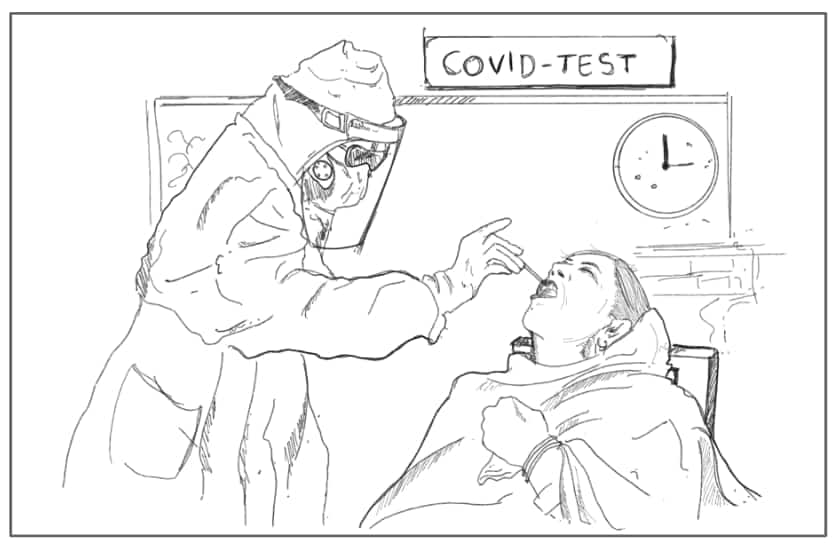
The CEED 2025 exam was conducted with a focus on both Part-A and Part-B, emphasizing visual skills, logical reasoning, and creativity. The exam also featured diverse question types such as Multiple Select Questions (MSQs), Multiple Choice Questions (MCQs), and Numerical Answer Type (NAT) questions. The Part-B section had a heavy emphasis on sketching and design interpretation. Below is a breakdown of the key elements of the exam:
There was an increased emphasis on visual problem-solving in Part-A, especially in the MSQ and NAT sections, which tested spatial awareness and the ability to visualize abstract ideas.
Part-B continued to test drawing proficiency but also placed more importance on storytelling and design communication, making the ability to convey ideas visually a crucial skill.
The 2026 CEED Examination could be expected to be more focused on Part B since sketching and addressing the visual challenges gives a better insight into the thought process of the aspirant.
You may be given a real-time scenario or situation from life, like a perspective view of the Railway station where you may be asked to identify the challenges from a third person with special abilities, or a pregnant woman.
Here an aspirant possesses two skills: empathy & practical approach to the solution and may do better than others. In the coming articles, we may share the exercises and activities in this regard.
Students preparing for CEED 2026 exam can go through these important free pdfs to download in order to help them prepare for the exam. Aspiring students can take help from these resources to prepare effectively and be more confident for the exam day:
| CEED 2026 Preparation Guide | Download Here |
| CEED 2026 High Weightage Topics | Download Here |
| CEED 2025 Official Question Paper with Detailed Solution | Download Here |
| CEED Official Sample Question - Solution Creation | Download Here |
Given that IITs does not recommend any particular books or study materials for CEED exam preparation. Nonetheless, the list of the best books for CEED preparation is provided below. Furthermore, these books are divided into sections that are divided into several parts.
Name of the Book | Name of the Author/Publication |
My Best Mathematical and Logic Puzzles | Martin Gardner Puzzles |
Cracking CEED \& UCEED (with Previous Years' Papers and Mock Tests) | Ashok Goel and Arjun Kamal |
Quantitative Aptitude | RS Aggarwal |
Verbal and Non-Verbal Reasoning | RS Aggarwal |
Name of the Book | Name of the Author/Publication |
CEED and NID M.Des Entrance Books and Test Series | Ashish Popli, Pradosh Swain, Rishabh Rhode |
Design Drawing | Francis DK Ching |
Perspective Drawing Handbook | Joseph D'Amelio |
Art Perception | David Cycleback |
Most Important Don'ts: Common mistakes include attempting the question carefully, where aspirants must read or interpret the questions correctly while attempting the NAT questions.
Frequently Asked Questions (FAQs)
The overall CEED exam can be considered moderate to difficult since the drawing part is a bit difficult as compared to the general aptitude test.
You can find CEED 2026 preparation material on its official website. Also, you can check the CEED Syllabus 2026 to have a look at the list of the following important topics.
The time required for CEED preparation will depend upon the aspirant skillset. Ideally, the preparation takes around 6 to 12 months with regular practice and hard work.
Make a well-structured study plan. Start preparing for the CEED exam by familiarising yourself with the syllabus, enhancing your drawing skills and solving previous years' question papers or sample papers.
On Question asked by student community
Hello,
To prepare for M.des exams like CEED or NID DAT, here are some points which you can follow:
Understand the pattern – focus on creativity, design aptitude, and problem-solving.
Practice sketching daily and improve visualization.
Study basics of color, form, and design concepts.
Solve previous papers and build a strong portfolio.
Stay consistent and observe everyday designs for new ideas.
THANKU.
Careers360 NIFT Study Material → Guides + 10 free mock tests → Careers360 NIFT Material
E-books & Sample Papers → Practice questions & previous papers → Careers360 NIFT E-books
Focus Areas: Creative Aptitude, General Ability, Situation Test.
Hii
Common Entrance Examination for Design is a test includes design aptitude, your creativity, visualisation, problem-solving, and also analytical ability.
CEED exam structure is divided in 2 parts (PART A & PART B) and you can check what to study and syllabus of CEED on career360 https://design.careers360.com/articles/ceed-syllabus-2025
CEED syllabus includes:
Visualization and spatial ability
Design thinking and problem solving
Drawing skills
Creativity
Communication skills
Analytical and logical reasoning
Environmental and social awareness
Observation and design sensitivity Also includes topics on form, function, aesthetics, and technical drawing.
Hello Anushka,
Thanks for reaching out!
You can definitely prepare for CEED to pursue UI/UX design.since you're not from design background you'll need 4-6 months of focused prepration.
Focus on:
Sketching
Visual communication
Design concepts
User experience basics
Problem - solving skills
Past CEED papers.
Practice drawings, story boarding, Idea generation daily.
You can also take online courses to learn design fundamentals and tools.
Consistency and practice matter most!
get all the detailed info here:
https://design.careers360.com/articles/ceed-syllabus
All the best!
Tie-ups with over 100 international Universities in USA, UK, France and Australia. Wide Range of scholarships available.
Ranked #45 Among Universities in India by NIRF | 1950+ Students Placed, 91% Placement, 800+ Recruiters
No. 1 Design & Fashion Institute by ASSOCHAM, India Today, Outlook and The Week rankings
NAAC A+ Accredited | Among top 2% Universities Globally (QS World University Rankings 2026)
Leading Design College | Highest CTC: ₹12 LPA | Average CTC: ₹7.5 LPA | Scholarships for Deserving Students
Choose Creative Edge by TopRankers for Design Test Preparation